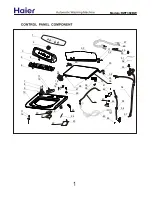
16
EN
CARE AND CLEANING
Normal operating sounds
Your dishwasher uses energy efficient
motors for the wash and drain portions
of the cycle you select. Each cycle has
a series of water fills and drains for
washing and rinsing dishes. As each
cycle begins, you may or may not hear
the drain motor. You may also hear the
splashing of water as it enters the tub
and the spray arms as they rotate and
circulate water. The wash motor often
pulsates throughout the cycle, which
varies water pressure and optimizes
performance.
Loud ticking can mean that something
is hitting wash arm. Vibrating or rattling
sounds can mean dishes are touching
each other. See Preparing and Loading
Dishes.
Removing spots and film
Hard water can cause lime deposit
buildup on the interior of the dishwasher.
Dishes and glasses may also get spots
and film for a number of reasons. (See
Glassware/Flatware Spotted or Cloudy
section). To remove buildup, and film,
clean using the following instructions:
1. Load clean dishes and glasses in
normal manner. Do not load any
metal utensils or silverware.
2. Do not add detergent.
3. Select the NORMAL cycle. Press
START. Close and latch the door.
4. Allow dishwasher to run until it starts
the second water fill (approximately
10 minutes).
5. Unlatch an and open door and pour 2
cups of white vinegar into the bottom
of dishwasher.
6. Close and latch door and allow cycle
to finish.
Factors affecting
performance
Water Pressure
The hot water line to dishwasher must
provide water pressure between 20 and
120 psi.
Low water pressure may occur when
laundry or showers are in operation. If
you experience poor wash performance
you may need to wait until water use is
reduced before starting dishwasher.
Water temperature
Hot water is needed for best dishwashing
and drying results. Water entering
dishwasher should be at least 120° F
(49° C) to give satisfactory results.
To check water temperature entering
dishwasher:
• Turn on hot water faucet nearest
dishwasher for several minutes to
clear cool water from pipes.
• Hold a candy or meat thermometer
in the water stream to check the
temperature.
• If temperature is below 120° F (49°
C), have a qualified person raise the
hot water heater thermostat setting.
NOTE
Before starting a cycle, run hot water
to clear cool water from pipes.
Summary of Contents for VILLKORLIG 404.621.69
Page 1: ...ES FR EN VILLKORLIG...
Page 22: ...A19405001 C Inter IKEA Systems B V 2020 2020 04 14 23430 AA 2194939 2...
Page 23: ...ES FR EN VILLKORLIG...
Page 44: ...A19405001 C Inter IKEA Systems B V 2020 2020 04 14 23430 AA 2194939 2...
Page 45: ...ES FR EN VILLKORLIG...
Page 66: ...22 FR...
Page 67: ...23 FR...
Page 68: ...A19405001 C Inter IKEA Syst mes B V 2020 2020 04 14 23430 AA 2194939 2...
















































